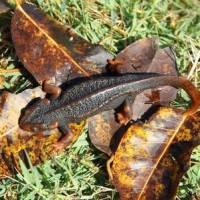A team of Japanese and Chinese biologists has discovered a new species of crocodile newt from Myanmar, a forerunner of a wave of new amphibian species awaiting description as the relatively unexplored country's "hidden biodiversity" is gradually revealed by science.
Conservationists, however, warn that the new species' only known populations in and around Taunggyi, the capital of Shan State in eastern Myanmar, are threatened by habitat loss, degradation and fragmentation, as well as commercial exploitation.
Describing their find in the latest issue of a Thai scholarly journal, the Natural History Bulletin of the Siam Society, the taxonomists from Kyoto University and the Kunming Institute of Zoology named the new species Tylototriton shanorum, dedicating its scientific name to the people of Shan State.
"Effective management for the protection of this new narrow-ranged species must be taken into action urgently," they advised, underscoring the need for timely conservation measures for the Shan crocodile newt.
Some 20 species of crocodile newts — also known as "knobby newts" due to two rows of blunt protrusions that run down their back — are found in Myanmar, China, Vietnam, Laos, Thailand, Nepal, India and Bhutan. More than half of these medium- to large-sized newts have been identified only in the past decade and most are legally protected — at least on paper.
In Taunggyi, which is set spectacularly on a mountain ridge at an altitude of 1,436 meters, the newts, which are mostly terrestrial, live under rocks, logs and debris in the vicinity of permanent or temporary shallow ponds, ditches and marshes to which they migrate during the rainy season for breeding.
According to Pe Than Kyaw, a Taunggyi University biology professor who has studied the newts' population dynamics and reproduction, they were long thought to be the more wide-ranging Himalayan crocodile newt, a closely related species found in neighboring countries and commonly encountered in the international pet trade.
He hoped the identification of the Shan crocodile newt as a genetically distinct species will stimulate local research into its life cycle and habitat requirements, while he stressed the need for field studies to determine its distribution and come up with effective conservation measures.
However, considering the fast pace of decline in the extent and quality of newt and other wildlife habitats in the growing township of some 400,000 people, the clock may be ticking for these possibly rare tailed amphibians.
Some once-pristine spots where locals recalled finding newts in their youth were found littered with rubbish, while their main breeding ponds on the campus of Taunggyi University, despite being in an area set aside as a "newt preserve," may soon dry out completely as nearby construction of a university building is poised to cut off the inflow of water in the absence of mitigation measures.
Other factors in the newts' decline include being run over by vehicles during their seasonal migrations to and from breeding ponds, as well as the loss of shady, moist places to hide, Pe Than Kyaw said.
Like other newts in the enigmatic Asian genus Tylototriton, the new species, though not as colorfully appealing as some, is also menaced by overharvesting for the international pet trade.
"Many Tylototriton kept in Europe seem to be Tylototriton shanorum, some of which might be captive-bred," said Kyoto University associate professor Kanto Nishikawa, the lead author of the new species description paper, adding that ones captive-bred ones are sometimes found in Japanese pet shops as well.
Indeed, another source said many, if not most, crocodile newts imported into Europe in the 1980s and 1990s and sold as the Himalayan crocodile newt may well have been the newly described species.
Commercial trade in wild newts "should be stopped from the viewpoint of conservation," Nishikawa said, while noting that the often unregulated and sometimes illegal newt trade also helps spread a dangerous fungus of Asian origin that has been killing off native salamander species in Europe in recent years.
An even more serious threat to these stout-bodied newts — which are sluggish and easily captured when found in shallow water during the breeding season — is from being collected for export to China where they are used in traditional medicine, Pe Than Kyaw said.
A decades-old account from Taunggyi states that certain superstitious locals used to regard these then-abundant "water lizards" as omens of bad luck and would maliciously trample them at every opportunity, a fate which befell 10 out of 40 newts that were tagged and released on the university's campus in an experiment.
These days, however, locals who come across a newt are more likely to consider it fortuitous, representing as it does "money ... something to sell to China," Pe Than Kyaw said.
The new species was identified on the basis of type specimens collected from Taunggyi over a decade ago by Kyi Soe Lwin, currently a project officer with Indo-Myanmar Conservation, an NGO that works to conserve Myanmar's wildlife, and other local scientists.
Teaming up with researchers from the California Academy of Sciences, they pushed the zoological frontier by extensively surveying Myanmar's amphibians and reptiles, to the extent possible given the country's delicate political and security environment.
According to American biologist Jeffery Wilkinson, who was deeply involved in that landmark project, most of Myanmar's reptiles are likely already known to science, but when it comes to amphibians, "we have only scratched the surface."
The project, which began in 1991 and ended some six years ago, resulted in the collection of more than 17,000 specimens out of which 26 new species were discovered, 19 of them reptiles.
"One might conclude (from this) that there's a higher hidden reptile diversity in the region than amphibian diversity. However, this is far from the truth," Wilkinson said.
He said morphological and DNA analyses of these specimens suggest there may be "at a minimum 50 new species of frogs" awaiting scientific description — possibly as many as 100, meaning the process of taxonomically uncovering Myanmar's hidden amphibian diversity has only really begun. Due to insufficient funding, however, the task will probably take years to accomplish.
With some of the most extensive intact forest in Southeast Asia, despite having suffered massive deforestation, Myanmar is one of the region's most biologically diverse nations. But as the country reengages with the world after decades of isolation, civil conflict and economic decline, its impressive biodiversity faces numerous challenges, ranging from wildlife poaching and both legal and illegal logging to extensive conversion of forest land for agribusiness.
International wildlife conservation group WWF recently featured the Shan crocodile newt in its annual "Magical Mekong" report, which highlighted 10 new species discovered in 2014 in the Greater Mekong Region. They were among a total 139 new species of flora and fauna — including 16 amphibians, 23 reptiles, nine fish and one mammal — discovered last year in the region that also encompasses Cambodia, Laos, Thailand and Vietnam. In total, the report says, more than 800 amphibian and reptile species, 430 mammals, 1,200 birds, 1,100 fish and 20,000 plant species call this region home.
Citing the myriad threats facing the Shan crocodile newt, some of which mirror those that confront potentially thousands of other as-yet-undiscovered species in the country, the report warned that these newts "may disappear just as we're getting to know them."
"Even if we can't stop construction and/or destruction, we can do something like mitigation," Nishikawa said. "Practically, it's important and much better than doing nothing."




